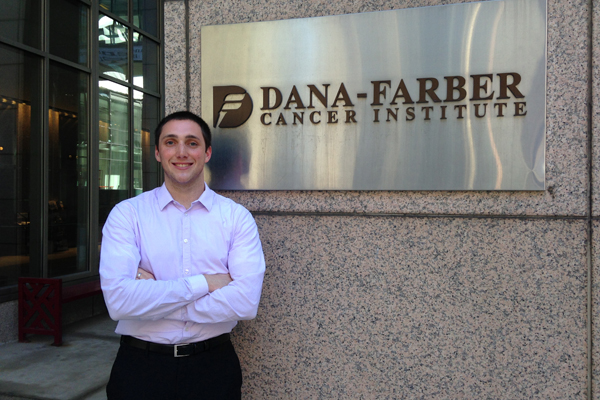Family’s health scare helps student find calling

When he was just 7 years old, graduating senior Kendall Sanderson’s mother was diagnosed with breast cancer. The tumor needed to be removed with emergency surgery, according to her son, but complications in the hospital’s scheduling protocol forced a three-week delay in the procedure.
To the industrial engineering major, one of the most fascinating problems to solve is the efficient routing of delivery trucks around the country. When Sanderson learned he could apply this skill to the healthcare industry to prevent mistakes like those made with his mother, he knew he’d found his calling.
During his second year at Northeastern, Sanderson began working in the Healthcare Systems Engineering Institute and National Science Foundation healthcare center of James Benneyan, a professor of mechanical and industrial engineering with an honorary joint appointment in the Bouvé College of Health Sciences. There, he learned about the tragedy of the healthcare system: “It’s a $3 trillion industry,” Sanderson said, “and about 30 percent of that can be attributed to inefficient, poorly designed processes.”
Through his three co-op assignments and independent research projects with Benneyan, Sanderson tailored his skillset to the underappreciated field of healthcare systems engineering. Instead of delivery truck routes, he’s considering patient flow through hospitals. Instead of manufacturing product supply and demand, he’s considering the ideal number of beds to place in a clinic.
At Boston’s Veteran’s Administration Hospital, Sanderson got his first taste of what it’s like to be an engineer in a world dominated by physicians and clinicians, whose main goal is to heal patients rather than efficiently move them around the hospital. In addition to turning the nursing supply closets into spreadsheets of data that could be analyzed and optimized, Sanderson assisted with process improvement workshops for the hospital employees to implement standard efficiency protocols on their own.
For his second co-op, Sanderson spent two months manually tracking all of the patient and clinician activity in the pediatric floor at Dana Farber Cancer Institute. Every 15 minutes he’d take note of where patients were—in the waiting room, say, or in a hospital room with a nurse. He turned his notes into a massive database that he used to model patient flow on the floor. With that kind of model in hand, he could identify the areas most often overcrowded or under-utilized and the best solutions to address them.
At Dana Farber, he also worked on a pilot study that automatically tracked that same information using sensors embedded in the clinic’s roof and tracking devices carried by patients during their visits. Implementing that system on a large scale would be an expensive undertaking, Sanderson explained, but the investment would be worth the cost if it could deliver sufficient waste savings.
Sanderson’s work earned him one of 17 university’s Outstanding Cooperative Education Awards this spring as well as the Society for Health Systems undergraduate scholarship, which is offered each year to one student in the country. He plans to join Benneyan’s new $8 million CMS center as a master’s degree candidate in the fall and to continue making the healthcare world more efficient over the course of his career.
His mother, who survived her bout of breast cancer, is no doubt quite proud.